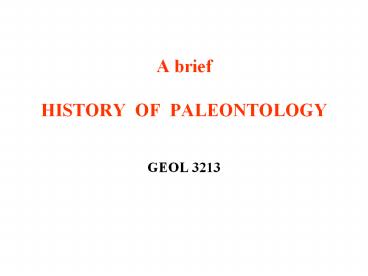A brief HISTORY OF PALEONTOLOGY - PowerPoint PPT Presentation
1 / 10
Title:
A brief HISTORY OF PALEONTOLOGY
Description:
A brief HISTORY OF PALEONTOLOGY ... of fossils and strata Leonardo Da Vinci ... dominate work Generalizations or principles were being developed 1900 to ... – PowerPoint PPT presentation
Number of Views:365
Avg rating:3.0/5.0
Title: A brief HISTORY OF PALEONTOLOGY
1
A briefHISTORY OF PALEONTOLOGY
- GEOL 3213
2
PRE-1750 PRE-SCIENTIFIC PERIOD
- Aristotle a few hundred years B.C.
- Founder of the science of biology
- Originated the type concept
- Believed in the immutability of species
- Made a crude hierarchical classification of
organisms - Wrote about genera and species
- Noahan flood (for some people) accounted for
fossils - extinctions
- Dark Ages 5th century to about 14th century
- Scientific explanations of the natural world
considered unacceptable because of church
opposition and political power - "Magical interpretations"
- "Plastic forces
- Devils doings
- Some correct interpretations of fossils and
strata - Leonardo Da Vinci
3
1750-1850 EARLY SCIENTIFIC PERIOD
- Linne's classification (revolutionized biology
in mid-1700's) - Followed Aristotles type concept, improved on
his hierarchical classification scheme, used
genus species - Fossils became recognized correctly more often
than before - Practical concepts applications being
discovered by pioneers - Principles (Hutton) 1st geol textbook (Lyell)
- Correlation age dating (Wm. Smith others)
- Paleoenvironmental interpretations (dOrbigny
others) - Geologic time scale (Sedgwick, Murchison, etc.)
- Earth history ( Historical geology developed,
many workers) - Debates controversies
- Evolution versus Catastrophism Special Creation
- Cuvier vs. Lamarck
- Beginnings of paleobotany, vertebrate
paleontology, invertebrate paleontology,
micropaleontology, paleoecology - Descriptive phase dominant
4
1850-1900 MIDDLE SCIENTIFIC PERIOD
- Darwin's theory of evolution (early 1850's 1858
1859) shook biology by its roots. Concept of
natural selection caused a scientific revolution.
Not enough fossils known to support him. - More fossils became better known
- Vertebrate
- Invertebrate
- Microfossils (dating aquifers from well cuttings,
Vienna, 1877) - Plants
- 1st paleontology textbook
- Evolution was becoming better documented with
fossils - Descriptive phase continued to dominate work
- Generalizations or principles were being
developed
5
1900 to Mid 20th Century
- Genetic theory developed in biology
- From the turn of the century
- Mendel's laws (1865) rediscovered
- Biological interest in fossils increased
- Evolutionary histories of invertebrate fossils
documented - Evolutionary concepts evaluated more with
vertebrate fossils - Practical applications of paleontology to
resource exploration - Micropaleontology matured early in century with
Foraminifera - Udden (1911), Augustina College, Illinois,
correlated aquifers with microfossils - Udden, Texas Bur. Econ. Geol., used microfossils
to find Petroleum - Many other workers followed his lead worldwide
- Faunal descriptions and documenting new species
still dominant
6
Mid-1900's to 2003 MODERN PERIOD
- New more sophisticated practical applications
of paleontology - Much more emphasis on principles of paleontology
(many new textbooks) - Greater biological interest in fossils
(Paleobiology) - Ichnology expanded and developed as a
subdiscipline - Paleoecology matured as a subdiscipline
- Greater evolutionary interest in fossils
(punctuated equilibrium theory of Elldredge
Gould, cladistic analysis of Hennig) - Literary explosion
- Micropaleontology diversified (ostracodes,
diatoms, pollen, dinoflagellates, coccoliths,
dinoflagellates, etc., not just forams ) - Popular paleontology boomed
- Hobyists collectors, amateurs
- Media sensationalism
- Vertebrate emphasis, especially dinosaurs
- Asteroid impacts and extraterrestrial causes of
extinctions - Declining of professional paleontologists -
inspite of popularity.
7
Epilogue CONTEMPORARY PALEONTOLOGY
- 1) Emphasizes less memorization (Really!)
- 2) More general biology, soft anatomy, ecology
emphasized - 3) Is more hypothesis, problem solving,
principles oriented - 4) Developing more interdisciplinary
quantitative studies - 5) Taxonomy still considered fundamental
- Documents diversity and evolution of life, etc...
- Represents
- Evolving concepts of evolutionary pathways
- Reflects guides philosophical approaches to
classification - Value of any fossil (in any application)
- Directly proportional to the quality of
identification, location, age, etc. - Poorly identified fossils result in inaccurate or
erroneous applications, conclusions - 6) Well located fossils (geography
stratigraphy) important to - Age-dating correlations
- Paleoecology paleoenvironmental studies
- Evolutionary studies
- Other practical applications
8
CONTEMPORARY PALEONTOLOGY
- 7) Three main, interrelated fronts
- Paleobiology evolution
- Paleoenvironments (strata) paleoecology
(organisms) - Biostratigraphy (age of fossils enclosing
strata) - 8) Interdisciplinary (more in some
subdisciplines) - Vertebrate paleontology is more zoological
(in Bio Depts) - Paleobotany is more botanical (in Bot or
Bio Depts) - Invertebrate paleontology is more geological
(in Geo Depts) - Micropaleontology is more geological (in
Geo Depts) - Invertebrate and Micropaleontology are more
applied, need more geological information,
stress the biology less. - Biology botany stress nonmarine organisms
- But most fossils are found in marine sedimentary
rocks, so that there is a strong oceanographic
orientation
9
CONTEMPORARY PALEONTOLOGY
- Examples of multidisciplinary studies
- Geochemical studies of isotopes trace elements
in skeletons, especially calcareous Foraminifera - Sophistocated mathematical analysis of fossil
data - Multivariate statistics
- Cluster and factor analyses
- Numerical taxonomy replaced by cladistic analysis
- Skeletal mineralogy and microstructures
- Functional morphological studies
- Paleobiogeography and plate tectonics
- Paleoclimatological studies
- Sedimentary basin analysis
- Facies paleoenvironments
- Correlation age determination
- Thermal maturation studies in HC exploration
(conodonts)
10
END OF FILE

